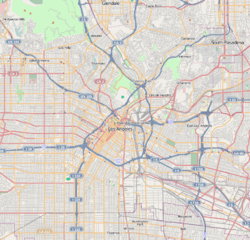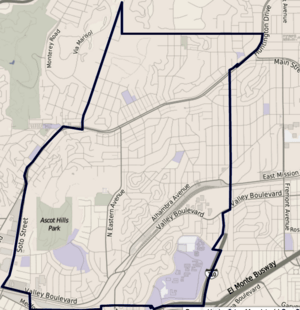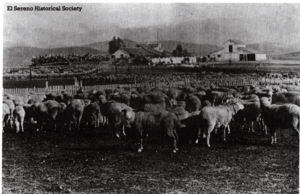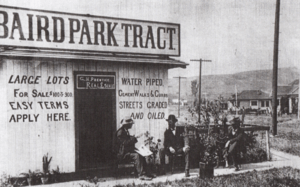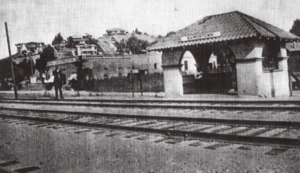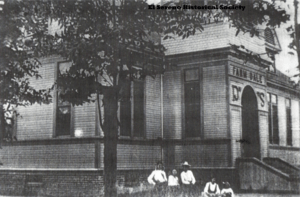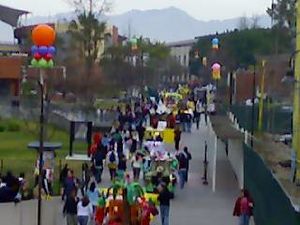El Sereno, Los Angeles facts for kids
Quick facts for kids
El Sereno
|
|
|---|---|
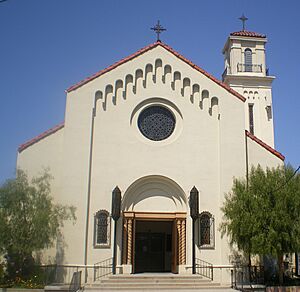
All Saints Catholic Catholic Church
|
|
| Country | United States |
| State | California |
| County | Los Angeles |
| City | Los Angeles |
| Area
<
|
|
| • Total | 4.1 sq mi (11 km2) |
| Population
(2000)
|
|
| • Total | 43,766 |
| • Density | 9,826/sq mi (3,794/km2) |
| Time zone | UTC-8 (PST) |
| • Summer (DST) | UTC-7 (PDT) |
| ZIP code |
90032, 90063
|
| Area code(s) | 323 |
| Website | El Sereno Historical Society |
El Sereno is a neighborhood in Los Angeles, California. Its name comes from a Spanish phrase meaning "The Serene One." It is located in the Eastside Los Angeles region of Los Angeles County, California.
Contents
- Exploring El Sereno's Past
- El Sereno's Location and Size
- Who Lives in El Sereno?
- Learning in El Sereno
- Public Libraries
- Places of Worship
- Community Services
Exploring El Sereno's Past
Early Inhabitants: The Tongva People
Long ago, the Tongva people lived in the area we now call El Sereno. Their village, called Otsungna, was next to a stream. This stream was later named Arroyo Rosa de Castilla. A path connected Otsungna to other villages, and this path eventually became Mission Road.
Spanish Rule (1769–1821)
Europeans first arrived in this area in 1769. Soon after, in 1771, the Mission San Gabriel Arcángel was founded. The land that is now El Sereno was part of the mission's property. It was used for grazing cattle. An adobe building was constructed there in 1776.
In 1784, a large piece of land called Rancho San Rafael was granted to Jose Maria Verdugo. El Sereno was not part of this ranch. Instead, it became part of a Mexican land grant called Rancho Rosa Castilla. Around 1810, a toll house was built near what is now Valley Boulevard.
Mexican Rancho Period (1831–1847)
After Mexico became independent from Spain in 1821, the Rancho Rosa de Castilla was granted to Juan Ballesteros in 1831. This ranch was named after the stream with roses growing on its banks. It covered the area of El Sereno and parts of other nearby communities. Later, the ranch was passed to Francisco Lopez.
American Ranch Period (1848–1901)
Land Ownership Changes
Around 1850, a priest named Anaclet Lestrade acquired Rancho Rosa de Castilla. In 1852, Jean-Baptiste Batz and his wife, Catalina Hegui Batz, bought the ranch house. They farmed and raised sheep. After Jean-Baptiste died, Catalina received official ownership of 160 acres. She bought more land, and the ranch grew to 3,283 acres. This large ranch included future communities like El Sereno.
After Catalina's death in 1882, her land was divided among her children. One son, Jose Domingo Batz, received 700 acres. Other families, like the Newtons, Smiths, and Cornwalls, also owned ranches in the area. They grew hay, raised horses, chickens, ducks, and pigs.
Slow Growth and Development
Between 1870 and 1900, El Sereno did not grow much. This was because there wasn't good transportation or enough water. Also, other nearby communities were developing faster. The wealthy landowners in El Sereno had no reason to develop their land quickly.
Roads and Transportation
By 1858, Butterfield stages traveled through the area on Valley Boulevard. Roses Road, established by 1873, later became part of Huntington Drive.
Railroads Arrive
The Southern Pacific Railroad built tracks through El Sereno in 1876. A stop was made at Aurant. Catalina Batz bought most of the land next to the tracks. Later, the Santa Fe Railroad also built tracks in 1887. Competition between the railroads lowered prices, bringing many new people to Los Angeles.
Water Supply Challenges
The main water sources were the Arroyo Rosa de Castilla and another ditch. A small reservoir was used by 1894. However, these sources were not enough for many new homes.
South Pasadena Connection
In 1888, parts of El Sereno were included in the city of South Pasadena. But in 1889, voters decided to remove the southern part of El Sereno from South Pasadena. This was because people in El Sereno did not want to live in a "dry" town where alcohol was banned. The Farmdale School District was created that same year.
Growth and Community Building (1902–1911)
In 1902, the Pasadena Short Line railway opened along Huntington Drive. This new rail line helped the area grow. Many new neighborhoods were created, especially around Farmdale Avenue (now Eastern Avenue) and Huntington Drive. However, most of these new areas did not attract many wealthy buyers.
As more people moved in, the community needed places to meet. A social center was started in 1911. It met at the Lincoln School Auditorium. The Bairdstown Improvement Association was also formed in 1911.
Llewellyn Baird, whose family helped develop the area, encouraged businesses to come. Early businesses included a plant nursery and a metal enameling company. A main shopping area with a grocery and post office was set up after 1903.
Before 1915, the area that became El Sereno felt like four different neighborhoods: Rose Hill, Bairdstown, Farmdale, and Sierra Vista. They were often grouped under the name "Bairdstown."
Becoming Part of Los Angeles (1912–1929)
Some parts of El Sereno joined the City of Los Angeles in 1912. The main part, Bairdstown, was annexed to Los Angeles on June 10, 1915. After this, the Bairdstown Improvement Association changed its name. A year later, Bairdstown was officially renamed "El Sereno." This name means "serene, quiet, unruffled place."
With the annexation, El Sereno's population grew. Many new buildings were constructed in the 1920s, including churches, theaters, and banks. Schools were expanded, and new middle-class homes were built.
Two new theaters, the one on Huntington Drive (1922) and the Cameo Theatre (1924), offered entertainment. A fire station and municipal building were built in 1927. A branch of the Bank of Alhambra opened in 1924.
Clubs and organizations also became popular. Groups like the Masons and the El Sereno Athletic Club offered social activities.
The Great Depression (1930–1938)
The Great Depression affected El Sereno. No new neighborhoods were built during the 1930s. The Sierra Vista neighborhood, which had its own school and railway station, felt like a separate community for a while.
World War II (1939–1945)
El Sereno's population grew a lot during World War II. Many people moved there to work in factories that made aircraft and weapons. They chose El Sereno because it was along the Pacific Electric railway lines, which helped with gas and rubber rationing. Many Italian-American families moved to the area during this time. The El Sereno Theatre was built in 1940.
After World War II
Before 1948, certain rules prevented Mexican-American families from buying homes in El Sereno. After a Supreme Court decision in 1948 (Shelly v. Kraemer), these rules were lifted. Many Mexican-American families then moved to El Sereno. New homes were built in the southern part of the neighborhood to meet the demand.
Today, like other areas in northeast Los Angeles, El Sereno is experiencing gentrification. This means that new people, often professionals and young families, are moving in. They are replacing some of the older and long-time homeowners.
El Sereno's Location and Size
El Sereno covers about 4.17 square miles. It has a population of 43,766 people. The population density is about 9,826 people per square mile, which is typical for Los Angeles.
El Sereno is surrounded by other communities. These include University Hills, Boyle Heights, East Los Angeles, Lincoln Heights, Montecito Heights, Highland Park, and the cities of Alhambra, Monterey Park, and South Pasadena.
A specific area within El Sereno is called Hillside Village.
Who Lives in El Sereno?
El Sereno is mostly a Mexican American community. In 2000, the most common backgrounds were Mexican (67.0%) and Chinese (4.7%). The average age was 28, which means it's a young community compared to the rest of the city. Many residents are 10 years old or younger. The average household has 3.5 people, which is high for the city and county. The average household income in 2008 was $45,866.
Data from the U.S. Census in 2010 showed that 79.6% of the population was Hispanic and 10.8% was Asian. The average household income was $47,359.
Learning in El Sereno
School History
Farmdale School was the first school in the area. Rose Hill School was built in 1909. Lincoln School, designed in the Mission style, was built in 1911. It was later known as Bairdstown School and then El Sereno School. The Sierra Vista School was built in 1913.
El Sereno School and Farmdale School were both expanded in 1924. El Sereno High School was built in 1936 on the site of the old Farmdale School. In 1937, the high school's name was changed to Wilson High School.
Education Levels
Only 9.4% of adults aged 25 and older in El Sereno have a four-year college degree. This is a lower number compared to the rest of Los Angeles. Also, a high percentage of adults in El Sereno have not finished high school.
Schools in El Sereno
Here are some of the schools in El Sereno:
- Public High Schools:*
- Anahuacalmecac (charter school)
- Los Angeles County High School for the Arts
- Woodrow Wilson High School
- Public Elementary Schools:*
- Academia Semillas del Pueblo (charter school)
- Cesar Chavez Elementary
- El Sereno Elementary
- Farmdale Elementary
- Huntington Drive Elementary
- Multnomah Street Elementary
- Sierra Park Elementary
- Sierra Vista Elementary
- Private Elementary School:*
- All Saints School
- Middle School:*
- El Sereno Middle School
Higher Education
- California State University, Los Angeles is located in El Sereno.
Public Libraries
A community library was started in 1915. However, a permanent library building was not built until 1959. The El Sereno Branch of the Los Angeles Public Library is now located on S. Huntington Drive.
Places of Worship
A Presbyterian church was built in 1908. Episcopal services began in 1911. A Catholic chapel was established in 1921, and a small church was built in 1926. A new Presbyterian church was built in 1923. The El Sereno Evangelical Lutheran Church was dedicated in 1928.
The Iglesia Bautista Mexicana de Rose Hills (Rose Hills Mexican Baptist Church) was founded in 1925. It later changed its name to Iglesia Bautista Emmanuel (Emmanuel Baptist Church) in 1954.
A new All Saints Catholic Church was completed in 1931. This was a big project for the Catholic residents. Most residents in El Sereno at the time were Protestants from Northern European backgrounds.
Community Services
The Los Angeles Fire Department has two stations in El Sereno: Station 16 (South El Sereno) and Station 47 (El Sereno). A fire station and municipal building were built in 1927. The neighborhood is served by the Los Angeles Police Department Hollenbeck Division.
The Los Angeles County Department of Health Services operates the Central Health Center in Downtown Los Angeles, which serves El Sereno.
El Sereno also has several public city parks. These include Ascot Hills Park, Guardia Park, and El Sereno Arroyo Playground.


